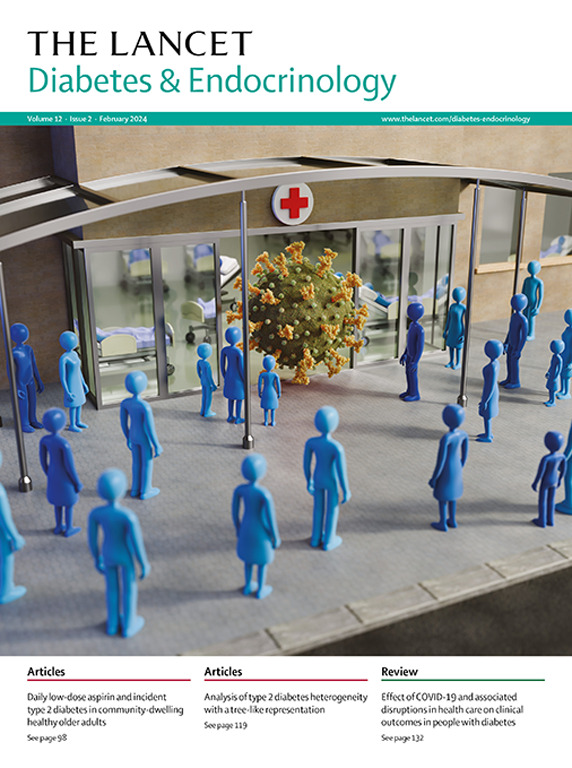Impact of bodyweight loss on type 2 diabetes remission: a systematic review and meta-regression analysis of randomised controlled trials
IF 44
1区 医学
Q1 ENDOCRINOLOGY & METABOLISM
引用次数: 0
Abstract
Background
Bodyweight loss is associated with type 2 diabetes remission; however, the quantitative relationship between the degree of bodyweight loss and the likelihood of remission, after controlling for confounding factors, remains unknown. We aimed to analyse the relationship between the degree of bodyweight loss and diabetes remission after controlling for various confounding factors, and to provide estimates for the effect sizes of these factors on diabetes remission.Methods
This systematic review and meta-regression analysis followed Cochrane and PRISMA guidelines to systematically review, synthesise, and report global evidence from randomised controlled trials done in individuals with type 2 diabetes and overweight or obesity. The outcome was the proportion of participants with complete diabetes remission (HbA1c <6·0% [42 mmol/mol] or fasting plasma glucose [FPG] <100 mg/dL [5·6 mmol/L], or both, with no use of glucose-lowering drugs) or partial diabetes remission (HbA1c <6·5% [48 mmol/mol] or FPG <126 mg/dL [7·0 mmol/L], or both, with no use of glucose-lowering drugs) at least 1 year after a bodyweight loss intervention. We searched PubMed, Embase, and trial registries from database inception up to July 30, 2024. Data were extracted from published reports. Meta-analyses and meta-regressions were performed to analyse the data. The study protocol is registered with PROSPERO (CRD42024497878).Findings
We identified 22 relevant publications, encompassing 29 outcome measures of complete diabetes remission and 33 outcome measures of partial remission. The pooled mean proportion of participants with complete remission 1 year after the intervention was 0·7% (95% CI 0·1–4·6) in those with bodyweight loss less than 10%, 49·6% (40·4–58·9) in those with bodyweight loss of 20–29%, and 79·1% (68·6–88·1) in those with bodyweight loss of 30% or greater; no studies reported on complete remission with 10–19% bodyweight loss. The pooled mean proportion of participants with partial remission 1 year after the intervention was 5·4% (95% CI 2·9–8·4) in those with bodyweight loss less than 10%, 48·4% (36·1–60·8) in those with 10–19% bodyweight loss, 69·3% (55·8–81·3) in those with bodyweight loss of 20–29%, and 89·5% (80·0–96·6) in those with bodyweight loss of 30% or greater. There was a strong positive association between bodyweight loss and remission. For every 1 percentage point decrease in bodyweight, the probability of reaching complete remission increased by 2·17 percentage points (95% CI 1·94–2·40) and the probability of reaching partial remission increased by 2·74 percentage points (2·48–3·00). No significant or appreciable associations were observed between age, sex, race, diabetes duration, baseline BMI, HbA1c, insulin use, or type of bodyweight loss intervention and remission. Overall, data were derived from randomised controlled trials with a low risk of bias in all quality domains.Interpretation
A robust dose–response relationship between bodyweight loss and diabetes remission was observed, independent of age, diabetes duration, HbA1c, BMI, and type of intervention. These findings highlight the crucial role of bodyweight loss in managing type 2 diabetes and reducing the risk of diabetes-related complications.Funding
Biomedical Research Program at Weill Cornell Medicine–Qatar and the Qatar National Research Fund (a member of Qatar Foundation).体重减轻对2型糖尿病缓解的影响:随机对照试验的系统回顾和荟萃回归分析
背景:体重减轻与2型糖尿病缓解有关;然而,在控制混杂因素后,体重减轻程度与缓解可能性之间的定量关系仍然未知。我们的目的是在控制各种混杂因素后,分析体重减轻程度与糖尿病缓解之间的关系,并估计这些因素对糖尿病缓解的影响大小。方法本系统综述和荟萃回归分析遵循Cochrane和PRISMA指南,系统回顾、综合和报告来自2型糖尿病和超重或肥胖患者的随机对照试验的全球证据。结果是在体重减轻干预后至少1年,糖尿病完全缓解(HbA1c和lt = 6.0% [42 mmol/mol]或空腹血糖[FPG]和lt = 100 mg/dL [5.6 mmol/L],或两者都缓解,不使用降糖药物)或糖尿病部分缓解(HbA1c和lt = 6.5% [48 mmol/mol]或FPG和lt = 126 mg/dL [7.0 mmol/L],或两者都缓解,不使用降糖药物)的参与者比例。我们检索了PubMed, Embase和从数据库建立到2024年7月30日的试验注册表。数据摘自已发表的报告。对数据进行meta分析和meta回归分析。研究方案已在PROSPERO注册(CRD42024497878)。研究结果:我们确定了22篇相关出版物,包括29项糖尿病完全缓解的结局指标和33项部分缓解的结局指标。干预1年后完全缓解的参与者的综合平均比例在体重减轻小于10%的患者中为0.7% (95% CI为0.1 - 0.6),体重减轻20-29%的患者中为49.6%(40.4 - 58.9),体重减轻30%或以上的患者中为79.1% (68.6 - 88.1);没有研究报道体重减轻10-19%后完全缓解。干预1年后部分缓解的参与者的综合平均比例在体重减轻小于10%的人群中为5.4% (95% CI 2.9 - 8.4),体重减轻10-19%的人群中为48.4%(36.1 - 60.8),体重减轻20-29%的人群中为69.3%(55.8 - 83.1),体重减轻30%或以上的人群中为89.5%(800 - 99.6)。体重减轻和病情缓解之间有很强的正相关。体重每减少1个百分点,达到完全缓解的概率增加2.17个百分点(95% CI 1.94 - 2·40),达到部分缓解的概率增加2.74个百分点(2.48 - 3.00)。未观察到年龄、性别、种族、糖尿病病程、基线BMI、HbA1c、胰岛素使用或体重减轻干预类型与缓解之间存在显著或可察觉的关联。总体而言,数据来源于随机对照试验,在所有质量领域的偏倚风险较低。研究发现,体重减轻和糖尿病缓解之间存在明显的剂量-反应关系,与年龄、糖尿病病程、HbA1c、BMI和干预类型无关。这些发现强调了体重减轻在控制2型糖尿病和降低糖尿病相关并发症风险方面的关键作用。资助威尔康奈尔医学卡塔尔生物医学研究项目和卡塔尔国家研究基金(卡塔尔基金会成员)。
本文章由计算机程序翻译,如有差异,请以英文原文为准。
求助全文
约1分钟内获得全文
求助全文
来源期刊

The Lancet Diabetes & Endocrinology
ENDOCRINOLOGY & METABOLISM-
CiteScore
61.50
自引率
1.60%
发文量
371
期刊介绍:
The Lancet Diabetes & Endocrinology, an independent journal with a global perspective and strong clinical focus, features original clinical research, expert reviews, news, and opinion pieces in each monthly issue. Covering topics like diabetes, obesity, nutrition, and more, the journal provides insights into clinical advances and practice-changing research worldwide. It welcomes original research advocating change or shedding light on clinical practice, as well as informative reviews on related topics, especially those with global health importance and relevance to low-income and middle-income countries. The journal publishes various content types, including Articles, Reviews, Comments, Correspondence, Health Policy, and Personal Views, along with Series and Commissions aiming to drive positive change in clinical practice and health policy in diabetes and endocrinology.
 求助内容:
求助内容: 应助结果提醒方式:
应助结果提醒方式:


